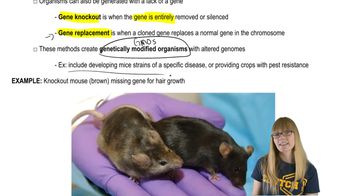Refer to Figure 13.7 to respond to the following:
A base-substitution mutation that altered the sequence shown in part (a) eliminated the synthesis of all but one polypeptide. The altered sequence is shown here:
5'-AUGCAUACCUAUGUGACCCUUGGA-3'
Determine why.
Ch. 15 - Gene Mutation, DNA Repair, and Transposition
Chapter 15, Problem 16
Dominant mutations can be categorized according to whether they increase or decrease the overall activity of a gene or gene product. Although a loss-of-function mutation (a mutation that inactivates the gene product) is usually recessive, for some genes, one dose of the normal gene product, encoded by the normal allele, is not sufficient to produce a normal phenotype. In this case, a loss-of-function mutation in the gene will be dominant, and the gene is said to be haploinsufficient. A second category of dominant mutation is the gain-of-function mutation, which results in a new activity or increased activity or expression of a gene or gene product. The gene therapy technique currently being used in clinical trials involves the 'addition' to somatic cells of a normal copy of a gene. In other words, a normal copy of the gene is inserted into the genome of the mutant somatic cell, but the mutated copy of the gene is not removed or replaced. Will this strategy work for either of the two aforementioned types of dominant mutations?
 Verified step by step guidance
Verified step by step guidance1
Identify the two types of dominant mutations: haploinsufficient and gain-of-function.
Understand that in haploinsufficiency, one normal allele is not enough for a normal phenotype, so adding a normal gene copy might help.
Recognize that in gain-of-function mutations, the mutation causes increased or new activity, so adding a normal gene copy may not counteract the mutation's effects.
Consider that gene therapy adding a normal gene copy could potentially restore normal function in haploinsufficient cases by increasing the gene product to a sufficient level.
Acknowledge that for gain-of-function mutations, simply adding a normal gene copy may not be effective, as the mutant gene's activity could still dominate.

Verified video answer for a similar problem:
This video solution was recommended by our tutors as helpful for the problem above.
Video duration:
6mWas this helpful?
Key Concepts
Here are the essential concepts you must grasp in order to answer the question correctly.
Haploinsufficiency
Haploinsufficiency occurs when a single functional copy of a gene is insufficient to maintain normal function, leading to a dominant phenotype. In this scenario, a loss-of-function mutation in one allele results in a phenotype that is expressed even in the presence of a normal allele. This concept is crucial for understanding how certain genetic disorders can manifest despite having one normal gene copy.
Recommended video:
Guided course

Mutations and Phenotypes
Gain-of-Function Mutations
Gain-of-function mutations lead to an increase in the activity or expression of a gene product, often resulting in a dominant phenotype. These mutations can create new functions or enhance existing ones, which can contribute to various diseases, including cancers. Understanding this concept is essential for analyzing how certain mutations can lead to abnormal cellular behavior.
Recommended video:
Guided course

Functional Genomics
Gene Therapy
Gene therapy involves introducing a normal copy of a gene into somatic cells to compensate for a mutated gene, aiming to restore normal function. This technique is particularly relevant for conditions caused by loss-of-function mutations. However, its effectiveness can vary depending on whether the mutation is haploinsufficient or a gain-of-function mutation, as the underlying mechanisms differ significantly.
Recommended video:
Guided course

Transgenic Organisms and Gene Therapy
Related Practice
Textbook Question
428
views
Textbook Question
The family of a sixth-grade boy in Palo Alto, California, was informed by school administrators that he would have to transfer out of his middle school because they believed his mutation of the CFTR gene, which does not produce any symptoms associated with cystic fibrosis, posed a risk to other students at the school who have cystic fibrosis. After missing 11 days of school, a settlement was reached to have the boy return to school. What ethical problems might you associate with this example?
253
views
Textbook Question
A significant number of mutations in the HBB gene that cause human β-thalassemia occur within introns or in upstream noncoding sequences. Explain why mutations in these regions often lead to severe disease, although they may not directly alter the coding regions of the gene.
448
views
Textbook Question
Contrast the structure of SINE and LINE DNA sequences. Why are LINEs referred to as retrotransposons?
562
views
Textbook Question
In 2013 the actress Angelina Jolie elected to have prophylactic double-mastectomy surgery to prevent breast cancer based on a positive test for mutation of the BRCA1 gene. What are some potential positive and negative consequences of this high-profile example of acting on the results of a genetic test?
517
views
Textbook Question
Describe how the Ames test screens for potential environmental mutagens. Why is it thought that a compound that tests positively in the Ames test may also be carcinogenic?
689
views
